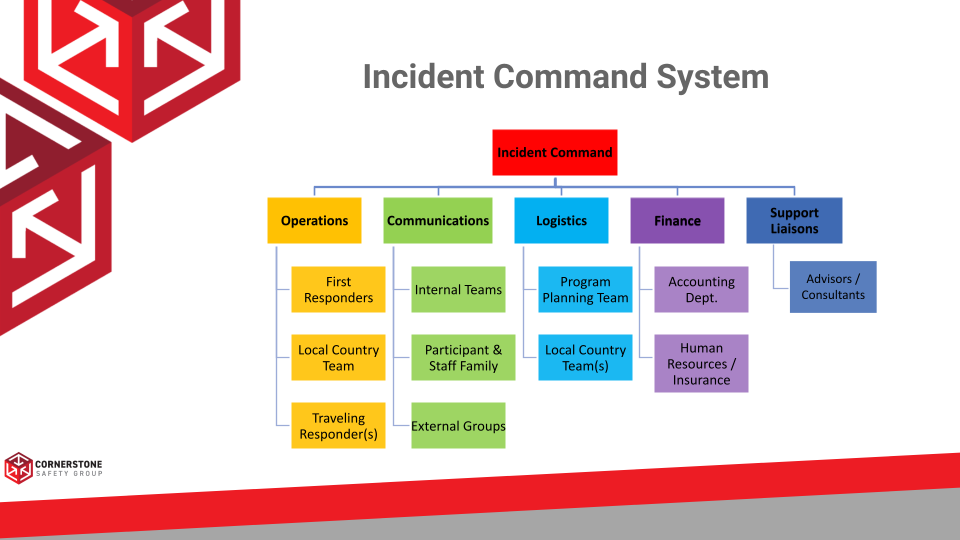Building a Crisis Response Team
As an experiential education or travel operator, you’re surely well-versed in incident response. Likely you have a plan of action for non-emergent, but stable, incidents that may occur in the field. Examples could include an injury, a hospital visit, or an individual accident.
An incident is an emergent, stable event with clear follow-up steps to ensure human safety and program integrity.
However, what about the crisis-level events? Events that can quickly snowball into more tragic or emergency events? Do you and your organization have a clear plan of action for how you respond to emergent, unstable events?
When a crisis occurs, your organization relies on your response plan, and the individuals responsible for each function, to act accordingly. Prepare today by following these guidelines for developing a Crisis Response Team.
Best Practices for establishing a Crisis Response Plan
As you know, we always promote leading with empathy and care. The first thing that your plan should do is address basic human needs for everyone involved - food, water, accommodation, transportation, and communication. If you’re incorporating all 5 of these elements into your plan, you’re likely completing your ethical obligation to provide duty of care.
Beyond basic needs, your plan should be focused on event containment. What practices and steps can you put in place that will prevent the crisis event from snowballing into a larger event? For example, in the case of a vehicle accident, who responds by preventing participants from wandering into the road and experiencing further risk? How do you put in “guardrails” to prevent secondary accidents? And how is your staff trained - do you practice these crisis-level responses in advance?
Take your plan one step further to document why you are creating a crisis plan in the first place. Not only to protect your staff and participants, but also the organization at large. At Cornerstone, we often refer to the “three C’s” in our response guidelines - care, compassion, control. Establishing your response plan and team should emphasize “control” wherever possible - limiting the impact of a crisis is critical.
You may not be able to control all events or crises, but you can develop the resources, training, and system to control situations as they occur.
Building your Crisis Response Team
Identifying and training the right individuals to respond in a crisis is key to implementing the Crisis Response Plan. After all, the plan relies on a series of individuals to take on specific roles and work together to respond quickly, effectively, and appropriately.
In the U.S., fire departments, police, first responders, even FEMA, all use the “Incident Command System” model when responding to crises in the field. This model assigns pre-established roles and responsibilities to organize effective response efforts. For the travel industry, Cornerstone has adapted this traditional system to reflect the roles necessary for responding to participant and staff events in the field.
When identifying the best fit for each role, consider the following:
Everyday functioning. The best person for the job will likely have skills they’ve already attained in that particular field. Does your marketing staff know how to quickly draft official communications and use specific messaging to engage with the media? They should be included on the communication team. Does your operations team have relationships with the in-field vendors? They need to be responsible for logistics for optimal efficiency.
Interest in the role. No one should be forced into a role on the crisis response team - in fact, if the individual is unprepared or unwilling to take on a particular role, they’ll be unable to keep things moving smoothly in a crisis.
Use of individual strengths. Do you have staff who are naturally great at engaging with participants and families? They likely should be included in family communications. Perhaps their day-to-day role doesn’t align specifically with this engagement, but their natural skillset could come in handy during a crisis.
Personal background. Don’t underestimate the power of empathy and experience when selecting individuals for your Crisis Response Team. If they have a passion for a particular area, they’re likely to perform this duty best during a crisis.
Don’t forget to consider who acts as secondary and tertiary roles. If one individual is sick or an entire team is at a conference, who responds quickly to crisis-level events? Make sure there’s a clear chain of command and redundancy needs are considered regardless of the size of your organization.
Most importantly, planning ahead and offering crisis response training is critical to developing a plan that works - and to keep your staff informed. No one is born with the natural skillset of responding to organization-wide crises, so it’s important that training include scenarios, examples, and run-throughs of your established systems.
You don’t need to go it alone! For more information on creating a crisis response plan, customized training for you and your leadership teams, or becoming a Cornerstone member, contact us at info@cornerstonesafetygroup.org.


